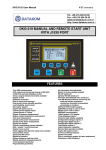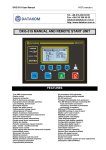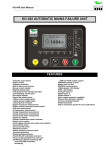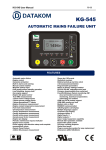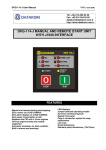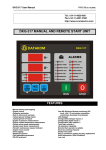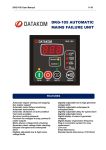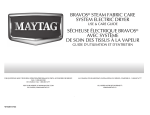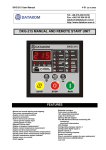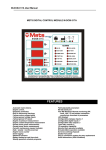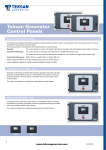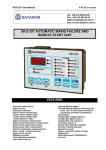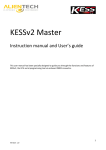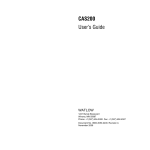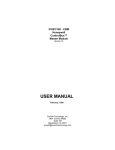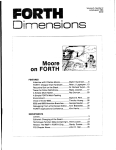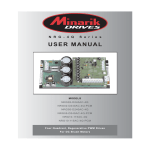Download DKG-507 AUTOMATIC MAINS FAILURE UNIT
Transcript
DKG-507 User Manual V-37 (01.03.2012) DKG-507 AUTOMATIC MAINS FAILURE UNIT CANBUS AND MPU VERSIONS DESCRIPTION The controller is a comprehensive AMF unit for single genset standby or dual genset mutual standby operations. The unit is available with MPU or CANBUS versions. The CANBUS version connects to ECU controlled electronic engines providing engine control, protection and instrumentation without extra senders. The unit is able to initiate modem calls and send SMS messages in fault conditions through external modems. The unit provides a comprehensive set of digitally adjustable timers, threshold levels, input and output configurations, operating sequences and engine types. All programs may be modified via front panel pushbuttons, and do not require an external unit. Last 100 faults are stored in the event log file. The event log includes not only the date-time information, but also a comprehensive list of measured genset parameters at the time that the fault has occurred. The WINDOWS based RAINBOW program allows remote monitoring and control. The unit supports MODBUS protocol enabling communication with PLCs and building management systems. The MODBUS protocol is also supported through GSM and PSTN modems. FEATURES True RMS measurements ECU connection through J1939 CAN option MPU input option Dual genset mutual standby operation Event logging with time stamp and measurements Battery backed-up real time clock Built in daily / weekly / monthly exerciser Weekly operation schedule programs Field adjustable parameters RS-232 serial port Free MS-Windows Remote monitoring SW GSM and PSTN modem support GSM SMS message sending on fault MODBUS communications Customer logo display capability 10ADC relay outputs Configurable analogue inputs: 4 Configurable digital inputs: 7 Configurable relay outputs: 2 Total relay outputs: 6 I/O expansion capability Plug-in connection system DKG-507 User Manual V-37 (01.03.2012) TABLE OF CONTENTS Section 1. INSTALLATION 1.1. Introduction to the Control Panel 1.2. Mounting the Unit 1.3. Wiring the Unit 2. INPUTS AND OUTPUTS 3. DISPLAYS 3.1. Led Displays 3.2. Digital Displays 4. ALARMS AND WARNINGS 5. MODES OF OPERATION 6. OTHER FEATURES 6.1. Remote start operation 6.2. Sender type selection 6.3. Engine heating operation 6.4. Engine Idle Speed Operation 6.5. Engine Block Heater 6.6. Fuel Pump Control 6.7. Mains Simulation (Disable Start) 6.8. Delayed Mains Simulation, Battery Charging 6.9. Dual Genset Mutual Standby Operation 6.10. Service Request Display 6.11. Engine Hours Meter 6.12. Date-Time Display 6.13. Display of Software Version 6.14. Modem connection 6.15. SMS message sending 6.16. Remote Monitoring and Programming 6.17. Automatic Exerciser 6.18. Resuming to factory set parameters 6.19. Gas engine fuel solenoid control 6.20. Load Shedding / Dummy Load 6.21. Fuel Theft / Fuelling Messages 6.22. Firmware Update 6.23. Changing the Default Engine Speed in Volvo Engines 6.24. Engine Control Mode 6.25. Dual Voltage and Frequency 6.26. Single Phase Operation 7. J1939 ENGINE MONITORING AND CONTROL PORT 8. MODBUS COMMUNICATION 9. WEEKLY OPERATION SCHEDULE 10. EVENT LOGGING 11. STATISTICAL COUNTERS 12. MAINTENANCE 13. PROGRAMMING 14. TROUBLESHOOTING 15. DECLARATION OF CONFORMITY 16. TECHNICAL SPECIFICATIONS 17. CONNECTION DIAGRAMS -2- DKG-507 User Manual V-37 (01.03.2012) 1. INSTALLATION 1.1 Introduction to the Control Panel The unit is a control and protection panel used in gensets. It shows the measured values on its displays. The unit is designed to provide user friendliness for both the installer and the user. Programming is usually unnecessary, as the factory settings have been carefully selected to fit most applications. However programmable parameters allow the complete control over the generating set. Programmed parameters are stored in a Non Volatile Memory and thus all information is retained even in the event of complete loss of power. The measured parameters are: Mains voltage phase L1 to neutral Mains voltage phase L2 to neutral Mains voltage phase L3 to neutral Mains voltage phase L1-L2 Mains voltage phase L2-L3 Mains voltage phase L3-L1 Gen voltage phase L1 to neutral Gen voltage phase L2 to neutral Gen voltage phase L3 to neutral Gen voltage phase L1-L2 Gen voltage phase L2-L3 Gen voltage phase L3-L1 Gen current phase L1 Gen current phase L2 Gen current phase L3 Gen frequency Engine speed (rpm) Gen total kW Gen total pf Battery voltage, Coolant temperature Oil pressure Oil temperature Fuel level -3- DKG-507 User Manual V-37 (01.03.2012) 1.2 Mounting the Unit The unit is designed for panel mounting. The user should not be able to access parts of the unit other than the front panel. Mount the unit on a flat, vertical surface. Before mounting, remove the mounting brackets and connectors from the unit, then pass the unit through the mounting opening. The unit will be maintained in its position by the mounting brackets spring. Engine body must be grounded for correct operation of the unit, otherwise incorrect voltage and frequency measurements may occur. The output of the current transformers shall be 5 Amperes. The input current rating of the current transformers may be selected as needed (between 10/5 and 9000/5 amps). Current transformer outputs shall be connected by separate cable pairs from each transformer, to related inputs. Never use common terminals or grounding. The power rating of the transformer should be at least 5 VA. It is recommended to use 1% precision transformers. If analogue senders (e.g. temperature, oil pressure or fuel level) are connected to the unit, it is not possible to use auxiliary displays, otherwise the unit may be damaged. If temperature or oil pressure or fuel level displays are already present on the generator control panel, do not connect the senders to the unit. The unit is factory programmed for VDO type senders. However different types of senders are selectable via programming menu. Please check the programming section. The programmable digital inputs are compatible with both „normally open‟ and „normally closed‟ contacts, switching either to BAT- or BAT+. The charge alternator connection terminal provides also the excitation current, thus it is not necessary to use an external charge lamp. 1.3 Wiring the Unit WARNING: THE UNIT IS NOT FUSED. Use external fuses for Mains phases: L1,L2,L3, Generator phase: L1,L2,L3, Battery positive: BAT(+). Install the fuses as nearly as possible to the unit in a place easily accessible for the user. The fuse rating should be 6 Amps. WARNING: ELECTRICITY CAN KILL ALWAYS disconnect the power BEFORE connecting the unit.The fuse rating should be 6 Amps. 1) ALWAYS remove the plug connectors when inserting wires with a screwdriver. 2) An appropriate and readily accessible set of disconnection devices (e.g. automatic fuses) MUST be provided as part of the installation. 3) The building mains supply MUST incorporate appropriate short-circuit backup protection (e.g. a fuse or circuit breaker) of High Breaking Capacity (HBC, at least 1500A). Use cables of adequate current carrying capacity (at least 0.75mm 2) and temperature range. -4- DKG-507 User Manual V-37 (01.03.2012) 2. INPUTS AND OUTPUTS RS-232 SERIAL PORT: This connector provides serial data input and output for various purposes like remote monitoring and remote programming. EXTENSION CONNECTOR: This connector is intended for the connection to output extension modules. The optional relay extension module provides 8 programmable 16A relay outputs. The unit allows the use of up to 2 I/O extension modules. Term Function 1 GENERATOR CONTACTOR 2 3 4 5 6 7 GEN-L1 GEN-L2 GEN-L3 GENERATOR NEUTRAL MAINS NEUTRAL MAINS-L3 8 9 10 MAINS-L2 MAINS-L1 MAINS CONTACTOR 11 12 GROUND BATTERY POSITIVE 13 FUEL LEVEL SENDER 14 OIL PRESSURE SENDER 15 COOLANT TEMP. SENDER Technical data Description Relay output, 16A-AC This output provides energy to the generator contactor. If the generator phases do not have acceptable voltage or frequency values, the generator contactor will be de-energized. In order to provide extra security, the normally closed contact of the mains contactor should be serially connected to this output. Generator phase Connect the generator phases to these inputs. inputs, 0-300V-AC The generator phase voltages upper and lower limits are programmable. Input, 0-300V-AC Neutral terminal for the generator phases. Input, 0-300V-AC Neutral terminal for the mains phases. Mains phase inputs, Connect the mains phases to these inputs. 0-300V-AC The mains voltages upper and lower limits are programmable. Relay output, 16A-AC This output provides energy to the mains contactor. If the mains phases do not have acceptable voltages, the mains contactor will be de-energized. In order to provide extra security, the normally closed contact of the generator contactor should be serially connected to this output. O VDC Power supply negative connection. +12 or 24VDC The positive terminal of the DC Supply shall be connected to this terminal. The unit operates on both 12V and 24V battery systems. Input, 0-5000 ohms Analogue fuel level sender connection. Do not connect the sender to other devices. The input has programmable ohms for VDO senders. Input, 0-5000 ohms Analogue oil pressure sender connection. Do not connect the sender to other devices. The input has programmable characteristics and connects to any kind of sender. Input, 0-5000 ohms Analogue high temperature sender connection. Do not connect the sender to other devices. The input has programmable characteristics and connects to any kind of sender. -5- DKG-507 User Manual V-37 (01.03.2012) Term Function 16 CHARGE Technical data Input and output 17 RELAY-2 (HORN RELAY) Output 10A/28VDC 18 RELAY-1 (STOP RELAY) Output 10A/28VDC 19 20 21 22 23 24 25 26 27 28 29 START RELAY FUEL RELAY EMERGENCY STOP SPARE-2 PROGRAM LOCK SPARE-1 COOLANT LEVEL HIGH TEMP LOW OIL PRESSURE RECTIFIER FAIL CURR_1+ Output 10A/28VDC Output 10A/28VDC Digital inputs 30 CURR_1- 31 CURR_2+ 32 CURR_2- 33 CURR_3+ 34 CURR_3- 35 OIL TEMP. SENDER Description Connect the charge alternator‟s D+ terminal to this terminal. This terminal will supply the excitation current and measure the voltage of the charge alternator. This relay has programmable function, selectable from a list. This relay has programmable function, selectable from a list. This relay controls the engine cranking. This relay is used for fuel solenoid control. These inputs have programmable characteristics selected via the program menu. Each input may be driven by a „normally closed‟ or „normally open‟ contact, switching either battery+ or battery-. The effect of the switch is also selectable from a list. See PROGRAMMING section for more details. Current transformer Connect the generator current transformer terminals to these inputs. Do not connect the inputs, 5A-AC same current transformer to other instruments otherwise a unit fault will occur. Connect each terminal of the transformer to the unit‟s related terminal. Do not use common terminals. Do not use grounding. Correct polarity of connection is vital. If the measured power is negative, then change the polarity of each 3 current transformers. The rating of the transformers should be the same for each of the 3 phases. The secondary winding rating shall be 5 Amperes. (For ex. 200/5 Amps). Input, 0-5000 ohms Analogue oil temperature sender connection. Do not connect the sender to other devices. The input has programmable characteristics and connects to any kind of sender. CANBUS VERSIONS 36 37 CANBUS-L CANBUS-H 36 37 MPU MPU + Digital communication Connect the J1939 port of an electronic port engine to these terminals. The 120 ohm terminating resistors are inside the unit. Please do not connect external resistors. Use a twisted cable pair or coaxial cable for best results. MPU INPUT VERSIONS Analog input, 0.5 to Connect the MPU unit to these inputs 30V-AC Use a twisted cable pair or coaxial cable for best results. -6- DKG-507 User Manual V-37 (01.03.2012) 3. DISPLAYS 3.1 Led Displays The unit has 12 LEDs, divided in 3 groups: -Group_1: Operating mode: This group indicates the genset function. -Group_2: Mimic diagram: This group indicates the current status of the mains and genset voltages and contactors. -Group_3: Warnings and alarms: This group indicates the existence of abnormal conditions encountered during operation. Function MAINS ON Color Green MAINS OFF Red LOAD MAINS LOAD GENERATOR GENERATOR Green Yellow Yellow TEST Yellow RUN Yellow STOP Yellow AUTO Green WARNINGS & ALARMS Red SERVICE REQUEST Red Description The LED will turn on when all 3 mains phase voltages are within the limits. The LED will turn on when at least one of the mains phase voltages is outside limits. It turns on when the mains contactor is activated. It turns on when the generator contactor is activated. The LED will flash when the engine is running. It will turn on steadily when all 3 generator phase voltages are within the programmed limits. It turns on when the related operation mode is selected. One of these LEDs is always on and indicates which operation mode is selected. If the operation of the genset is disabled by the weekly operation schedule, then the AUTO led will flash. If a fault condition resulting to the engine shutdown or loaddump condition has occurred, the related alarm led turns on steadily. If a warning condition occurs, this led will flash. Alarms work on a first occurring basis. The occurrence of a fault will disable other faults of lower or equal priority. Engine periodic maintenance request indicator. It turns on when the preset engine hours or time duration after previous service has elapsed. -7- DKG-507 User Manual V-37 (01.03.2012) 3.2 Digital Displays The unit has 3 seven segment displays. They show: -Measured parameters, -Service counters, -Statistical counters, -Program parameters. The navigation between different screens in a group is made with the MENU► button. Holding the MENU► button pressed for 1 second makes the display to switch to the next group. VOLTAGE DISPLAY: This display shows: -phase R voltage if the load is on mains -Phase U voltage if the load is on the genset By pressing the MENU key, below values may be displayed: -(L1-L2-L3) mains phase to neutral voltages -(L1-L2-L3) generator phase to neutral voltages -(L12-L23-L31) mains phase to phase voltages -(L12-L23-L31) generator phase to phase voltages If the service counters group is displayed, then this display will show the counter name. In programming mode it displays (PGM). CURRENT DISPLAY: This display will show the current values measured using the current transformers. Using the programming menu, current transformers within the range of 10/5A to 9000/5A may be programmed. In programming mode it displays the program number. MULTIFUNCTION DISPLAYS: By pressing the MENU key below values may read: -generator frequency (Hz) -generator active power (KW) -engine rpm -fuel level -oil temperature -battery voltage (V-DC), In programming mode it displays the program value. -8- DKG-507 User Manual V-37 (01.03.2012) 4. ALARMS AND WARNINGS Alarms indicate an abnormal situation in the generating set are divided into 3 priority levels: 1- ALARMS: These are the most important fault conditions and cause: - Therelated ALARM led to be on steadily, - The genset contactor to be released immediately, - The engine to be stopped immediately, - The Horn, Alarm, Alarm+Load_dump and Alarm+Load_dump+Warning digital outputs to operate, (if selected via programming menu) 2- LOAD_DUMPS: These fault conditions cause: - Therelated ALARM led to be on steadily, - The genset contactor to be released immediately, - The engine to be stopped after Cooldown period, - The Horn, Alarm+Load_dump and Alarm+Load_dump+Warning digital outputs to operate, (if selected via programming menu) 3- WARNINGS: These conditions cause: - Therelated ALARM led to flash, - The Horn and Alarm+Load_dump+Warning digital outputs to operate, (if selected via programming menu) If the ALARM MUTE button is pressed, the Horn output will be deactivated; however the existing alarms will persist and disable the operation of the genset. Alarms operate in a first occurring basis: -If an alarm is present, following alarms, load_dumps and warnings will not be accepted, -If a load_dump is present, following load_dumps and warnings will not be accepted, -If a warning is present, following warnings will not be accepted. Alarms may be of LATCHING type following programming. For latching alarms, even if the alarm condition is removed, the alarms will stay on and disable the operation of the genset. The existing alarms may be canceled by pressing one of the operating mode buttons (LOAD TEST / TEST / OFF / AUTO). Most of the alarms have programmable trip levels. See the programming chapter for adjustable alarm limits. -9- DKG-507 User Manual V-37 (01.03.2012) LOW OIL PRESSURE: Set if a signal is detected at the Low Oil Pressure Switch input or the oil pressure value measured from the sender is below the programmed limit. Warning and alarm limits are separately programmable for the oil pressure sender input. This fault will be monitored with Holdoff Timer delay after the engine is running. Also if the oil pressure switch is open at the beginning of a start attempt, then the engine will not be started and the oil pressure alarm led will flash. When the oil pressure switch closes, normal operation will be resumed. HIGH TEMPERATURE: Set if a signal is detected at the High Temperature Switch input or the coolant temperature value measured from the sender is above the programmed limit. Warning and alarm limits are separately programmable for the temperature sender input. LOW TEMPERATURE (warning) : Set if the coolant temperature value measured from the sender is blow the Engine Heating Temperature limit. LOW SPEED / HIGH SPEED: Set if the generator frequency or rpm is outside programmed limits. These faults will be monitored with Holdoff Timer delay after the engine is running. Low and high limits for warning and alarm are separately programmable. Another high shutdown limit which is 12% above the high limit is always monitored and stops the engine immediately. START FAIL (alarm): Set if the engine is not running after programmed number of start attempts. STOP FAIL (warning): Set if the engine has not stopped before the expiration of the Stop Timer. ECU FAIL (warning): Set when an engine fault code is received from the ECU of the electronic engine. This fault will not cause an engine stop. If necessary, the engine will be stopped by the ECU. ECU FAIL (alarm): Set if no information has been received during 3 seconds from the ECU of the electronic engine. This fault condition is only controlled if fuel is on. OVERLOAD (load_dump): Set if at least one of the genset phase currents goes over the Overcurrent Limit for Overload Timer. If currents go below the limit before expiration of the timer then no alarm will be set. EXCESS POWER (load_dump): Set if the genset power (KW) supplied to the load goes over the Excess Power limit for Overload Timer. If the power goes below the limit before expiration of the timer then no alarm will be set. GENSET LOW VOLTAGE: Set if any of the generator phase voltages goes outside programmed limits for Overload Timer. This fault will be monitored with holdoff timer delay after the engine is running. GENSET HIGH VOLTAGE: Set if any of the generator phase voltages goes outside programmed limits for Overload Timer. This fault will be monitored with holdoff timer delay after the engine is running. LOW COOLANT LEVEL: Set if a signal is detected at the low coolant level input. HIGH BATTERY VOLTAGE: Set if the battery voltage goes above programmed limits. Both warning and alarm levels for high battery voltage are programmable. LOW BATTERY VOLTAGE (warning): Set if the battery voltage goes below the programmed limit. During engine cranking this fault is not monitored. CHARGE: Set if a charge alternator failure (or broken belt) occurs. This fault condition may result to a warning or alarm following programming. RECTIFIER FAIL: Set if a signal is detected at the rectifier fail input. This input is only monitored when mains voltages are present. EMERGENCY STOP: Set if a signal is detected at the emergency stop input. SPARE: Set if a signal is detected from the related spare fault input. - 10 - DKG-507 User Manual V-37 (01.03.2012) 5. MODES OF OPERATION The modes of operation are selected by pushing the front panel keys. Changing the operation mode while the genset is running will result into a behavior suitable for the new operating mode. For example, if the TEST mode is selected when genset is running at RUN mode, then the genset will take the load. STOP: In this mode, the mains contactor will be energized if mains phase voltages are within the programmed limits. The engine will be stopped. AUTO: It is used for genset and mains automatic transfer. If at least one of the mains phase voltages is outside limits, the mains contactor will be deactivated. The diesel will be started for programmed times after the preheat timer. When the engine runs, the crank relay will be immediately deactivated. The engine will run without load during engine heating period. After this, if alternator phase voltages and frequency are within limits, then the unit will wait for the generator contactor period and the generator contactor will be energized. When all the mains phase voltages are within the limits, the engine will continue to run for the mains waiting period. At the end of this period the generator contactor is deactivated and the mains contactor will be energized. If a cooldown period is given, the generator will continue to run during cooldown period. At the end of the period, the fuel solenoid will be de-energized and the diesel will stop. The unit will be ready for the next mains failure. If the operation of the genset is disabled by the weekly schedule, then the AUTO led will flash, and the operation of the genset will be as in the OFF mode. RUN: It is used to test the generator when the mains are on, or keep the generator running in the emergency backup mode. The operation of the generator is similar to the AUTO mode, but the mains contactor will not be deactivated if the mains are not off. If the mains are off, mains contactor will be deactivated and the generator contactor will be activated. When the mains are on again, a changeover to the mains will be made, but the engine will be kept running unless another mode is selected. To stop the engine, select AUTO or OFF mode. TEST: It is used to test the genset under load. Once this mode is selected, the engine will run and the load will be transferred to the genset. The genset will feed the load indefinitely unless another mode is selected. - 11 - DKG-507 User Manual V-37 (01.03.2012) 6. OTHER FEATURES 6.1 Remote Start Operation The unit offers the possibility of REMOTE START mode of operation. The SPARE-2 input may be assigned as Remote Start Input using the program parameter P_083. The REMOTE START signal may be a NO or NC contact, switching to either battery positive or battery negative. These selections are made using programming menu. It is also necessary to set the ACTION program parameter of the SPARE-2 input to 3 in order to prevent any alarm from this input. In this mode the mains phases are not monitored. If the REMOTE START signal is present then the mains will be supposed to fail, inversely if the REMOTE START signal is absent, then mains voltages will be supposed to be present. The front panels mimic diagram‟s mains LEDs will reflect the status of the REMOTE START input. 6.2 Sender type Selection The unit has the ability to adapt to any type of oil pressure and temperature senders. The commonly used standard sender characteristics are recorded in memory and selectable from a list. However non standard senders may also be used by entering their characteristics to the table. Oil Pressure Sender Type Selection: Selectable sender types are: 0: Sender characteristics are defined in Sender Characteristics table. 1: VDO 0-7 bars (10-180 ohms) 2: VDO 0-10 bars (10-180 ohms) 3: DATCON 0-7 bars (240-33 ohms) 4: DATCON 0-10 bars (240-33 ohms) 5: DATCON 0-7 bars (0-90 ohms) 6: DATCON 0-10 bars (0-90 ohms) 7: DATCON 0-7 bars (75-10 ohms) Temperature Sender Selection: Selectable sender types are: 0: Sender characteristics are defined in Sender Characteristics table. 1: VDO 2: DATCON DAH type 3: DATCON DAL type Fuel Level Sender Selection: The Fuel Level Sender characteristic is programmable through table. Oil Temperature Sender Selection: Selectable sender types are: 0: Sender characteristics are defined in Sender Characteristics table. 1: VDO 2: DATCON DAH type 3: DATCON DAL type - 12 - DKG-507 User Manual V-37 (01.03.2012) 6.3 Engine Heating Operation Especially on engines without a body heater, or with a failing one, it may be desired that the genset should not take the load before reaching a suitable temperature. The unit offers 2 different ways of engine heating. 1. Timer controlled heating: This operation mode is selected when the Engine Heating Method parameter is set to 0. In this mode, the engine will run during parameter Engine Heating Timer, and then the genset will take the load. 2. Timer and temperature controlled heating: This operation mode is selected when the Engine Heating Method parameter is set to 1. In this mode, at first the engine will run during parameter Engine Heating Timer, then it will continue to run until the measured coolant temperature reaches the limit defined in parameter Engine Heating Temperature. When the requested temperature is reached, the load will be transferred to the genset. This operation mode may be used as a backup to the engine body heater. If the engine body is warm the heating will be skipped. 6.4 Engine Idle Speed Operation It may be required that the engine runs at the idle speed for a programmed duration for engine heating. The idle operation duration is adjusted with the parameter Idle Speed Timer. The idle speed will be set by the governor control unit of the engine. Any of the spare relay outputs may be assigned as IDLE output using Relay Definition program parameters. Also relays on an extension module may be assigned to this function. The Idle speed operation is performed both in engine start-up and cool-down sequences. Speed and voltage protections are disabled during idle speed operation. 6.5 Engine Block Heater The unit is able to provide a relay output in order to drive the block heater resistor. The temperature reference is the coolant temperature measured from the the analog sender input. The block heater relay function may be assigned to spare relays using Relay Definition program parameters. Also relays on an extension module may be assigned to this function. The engine body temperature limit is adjusted using the parameter Engine Heating Temperature. The same parameter is used for engine heating operation. The relay will become active if the body temperature falls to 4 degrees below the limit set by Engine Heating Temperature. It turns off when the body temperature exceeds Engine Heating Temperature. - 13 - DKG-507 User Manual V-37 (01.03.2012) 6.6 Fuel Pump Control The unit is able to provide a relay output in order to drive the fuel pump motor. The fuel pump is used in order to transfer fuel from the large capacity main tank (if exists) to the genset daily tank which is generally integrated in the chassis and has a limited capacity. The fuel level reference is measured through the analog fuel level sender. When the measured fuel level falls below Fuel Pump Low Limit parameter, the fuel pump relay output will operate. When the fuel level reaches Fuel Pump High Limit parameter, the relay will turn off. Thus the chassis fuel tank level will be always kept between Fuel Pump Low Limit and Fuel Pump High Limit parameters. The fuel pump relay function may be assigned to spare relays using Relay Definition program parameters. Also relays on an extension module may be assigned to this function. 6.7 Mains Simulation (Disable Start) The unit offers an optional SIMULATE MAINS signal input. The SPARE-2 digital input may be assigned as Simulate Mains using program parameter P_084. It is also necessary to set the ACTION program parameter of the related input to 3 in order to prevent any alarms generated from this input. The SIMULATE MAINS signal may be a NO or NC contact, switching to either battery positive or battery negative. These selections are made using the programming menu. If the Simulate Mains input is defined and the input signal is active, the mains phases are not monitored and supposed to be inside limits. This will prevent the genset from starting even in case of a mains failure. If the genset is running when the signal is applied, then usual Mains Waiting and Cooldown cycles will be performed before engine stop. When the SIMULATE MAINS signal is present, the front panels mimic diagram‟s mains LEDs will reflect the mains voltages as present. When the signal is passive, the unit will revert to normal operation and monitor the mains voltage status. The REMOTE START operation overrides SIMULATE MAINS and FORCE TO START operations. - 14 - DKG-507 User Manual V-37 (01.03.2012) 6.8 Delayed Mains Simulation, Battery Charging The Delayed Mains Simulation feature is used in battery backed up telecom systems where batteries are able to supply the load during a certain period. The genset is requested to run only when battery voltage drops below the critical level. Once the engine runs, the rectifier system starts charging the batteries and the battery voltage goes up immediately. Thus the engine should continue to run a programmed period for effective charging. The critical battery voltage level will be detected by an external unit which provides the digital Simulate Mains signal for the genset control unit. The unit offers an optional SIMULATE MAINS signal input. The SPARE-2 digital input may be assigned as Simulate Mains using program parameter P_084. It is also necessary to set the ACTION program parameter of the related input to 3 in order to prevent any alarms generated from this input. The SIMULATE MAINS signal may be a NO or NC contact, switching to either battery positive or battery negative. These selections are made using the programming menu. If the Delayed Simulate Mains program parameter (P_085) is set to 1 and the input signal is active when the genset is not feeding the load, the mains phases are not monitored and supposed to be inside limits. This will prevent the genset from starting when the simulate mains signal is present (batteries charged). The genset will start when mains voltages are out of limits and the simulate mains signal not present. If the genset is running when the signal is applied, then MAINS SIMULATION will be prevented during P_086 Flashing Relay Timer program parameter. After this, usual Mains Waiting and Cooldown cycles will be performed before engine stop. When the SIMULATE MAINS signal is present, the front panels mimic diagram‟s mains LEDs will reflect the mains voltages as present. When the signal is passive, the unit will revert to normal operation and monitor the mains voltage status. The REMOTE START operation overrides DELAYED SIMULATE MAINS operation. When both parameters “Remote Start Operation” and “Delayed Simulate Mains” are set then REMOTE START operation mode is performed. - 15 - DKG-507 User Manual V-37 (01.03.2012) 6.9 Dual Genset Mutual Standby Operation Dual genset intermittent operation consists of regular switching of the load between 2 gensets. The use of 2 gensets instead of one is due either to safety purposes in case of a genset failure or to a continuous operation requesting service stops. The running period for each genset is adjustable using Flashing Relay Timer program parameter. If the time is adjusted as 0 hours, it will be actually set to 2 minutes for faster testing purposes. A flashing relay output function is provided, based on the parameter Flashing Relay Timer. Each time the period programmed using Flashing Relay Timer elapses, the relay output will change position. The flashing relay function may be assigned to spare relays using Relay Definition program parameters. Also relays on an extension module may be assigned to this function. The dual genset intermittent operation uses also the Mains Simulation feature. Please review chapter 6.7 for a detailed explanation of this feature. Please contact DATAKOM for a complete application manual. - 16 - DKG-507 User Manual V-37 (01.03.2012) 6.10 Service Request Display This led is designed to help the periodic maintenance of the genset to be made consistently. The periodic maintenance is basically carried out after a given engine hours (for example 200 hours), but even if this amount of engine hours is not fulfilled, it is performed after a given time limit (for example 12 months). The SERVICE REQUEST led has no effect on the genset operation. The unit has both programmable engine hours and maintenance time limit. The engine hours is programmable with 50-hour steps, the time limit is programmable with 1 month steps. If any of the programmed values is zero, this means that the parameter will not be used. For example a maintenance period of 0 months indicates that the unit will request maintenance only based on engine hours, there will be no time limit. If the engine hours is also selected as 0 hours this will mean that the SERVICE REQUEST display will be inoperative. When the engine hours OR the time limit is over, the SERVICE REQUEST led (red) will start to flash and the service request relay function will be active. The service request relay function may be assigned to spare relays using Relay Definition program parameters. Also relays on an extension module may be assigned to this function. To turn off the SERVICE REQUEST led, and reset the service period, press together the ALARM MUTE and LAMP TEST keys for 5 seconds. The remaining engine hours and the remaining time limit are kept stored in a non-volatile memory and are not affected from power supply failures. The time and engine hours to service are displayed in the STATISTICAL COUNTERS menu. - 17 - DKG-507 User Manual V-37 (01.03.2012) 6.11 Engine Hour Meter The unit features a non-erasable incremental engine hour meter. The hour meter information is kept in a non-volatile memory and is not affected from power supply failures. The engine hours may be displayed STATISTICAL COUNTERS menu. 6.12 Date & Time Display The date & time display is provided for verification. 6.13 Software Version Display Some additional features are installed within consecutive software releases. In order to be sure of the validity of the status of the unit, the software version needs to be known. The software version of the unit is displayed together with the data – time information. The software version consists of 2 numbers. The first number represent the operating software version of the unit. 6.14 Modem Connection The unit is capable of making modem calls in case of alarm, as well as answering modem calls made from a remote location. GSM modems and classic cable network (PSTN) modems are acceptable. If the modem is connected to the unit, the Modem Enable program parameter should be set to 1, otherwise faulty operation may occur. A maximum of 2 telephone numbers can be defined for outgoing modem calls. In case of alarm, the unit will attempt to reach control centers associated with each number. In case of modem connection failure, the call will be repeated up to 30 times with 2 minute intervals. If Modem Enable or SMS Enable or MODBUS Address parameters are different from zero, the local PC connection will not work. Advised modems are DATAKOM types which are powered up from the same DC battery voltage than the unit. Most of other desktop modems with standard AT commands are also usable, but it is the user‟s responsibility to provide an uninterrupted AC supply source to the modem. The necessary modem cable will be supplied by DATAKOM. Modem calls are always terminated by the central RAINBOW software. However the unit does not allow connection durations exceeding 2 minutes, and hangs up the modem when this period expires. The PC program used for remote monitoring and programming is the same RAINBOW software used for RS-232 connection. Please note that the modem operation is also compatible with the MODBUS communication. Thus the unit can iniate and receive calls to/from a MODBUS master station. Please review chapter_8 for more details on MODBUS communication. - 18 - DKG-507 User Manual V-37 (01.03.2012) 6.15 SMS Message Sending The GSM SMS sending is activated by setting the SMS Enable program parameter to 1. If Modem Enable or SMS Enable or MODBUS Address parameters are different from zero, the local PC connection will not work. When a fault condition occurs, the unit will compose an SMS message and will send it to up to 6 phone numbers. If modem is enabled, only 4 telephone numbers are available for SMS sending. The unit is also able to send SMS messages in below conditions, without creating a visible alarm or warning: Mains Fail, Mains Restored (enabled via SMS on Mains Change program parameter) Fuel Theft, Fuelling (enabled by setting the Fuel Consumption / Hour parameter to other than 0) If both modem and SMS are enabled, the unit will send SMS messages first and attempt modem connection afterwards. The maximum number of alarms transmitted in a SMS message is 4. This limitation is due to the maximum length of an SMS message which is 160 characters. A sample GSM SMS message is given below: DKGxxx <SITE-ID> STOP :LOW OIL PRESSURE SW. END OF ALARM LIST The first line of the message carries information about the unit type and the site identity string. This line is intended for the identification of the genset sending the SMS message. Each following line will give one fault information. The message will always be terminated by the “END OF ALARM LIST” string. When the message is sent, the existing alarms will be masked, causing the audible alarm relay to release and preventing consecutive GSM SMS messages. Any new upcoming alarm will result in a new GSM SMS message. The new message will indicate all existing alarms, even masked ones. The necessary GSM modem cable will be supplied by DATAKOM. This is the same cable as PSTN (land) modems. - 19 - DKG-507 User Manual V-37 (01.03.2012) 6.16 Remote Monitoring and Programming Thanks to its standard serial RS-232 port, the unit offers the remote monitoring and programming feature. The remote monitoring and programming PC software is called RAINBOW and may be downloaded from www.datakom.com.tr internet site with password login. The modem, SMS and Modbus modes are not compatible with the local PC connection. Modem Enable, SMS Enable and MODBUS Address program parameters should be set to 0 before connection. The RAINBOW software allows the visualization and recording of all measured parameters. The recorded parameters may then be analyzed graphically and printed. The software also allows the programming of the unit and the storage of the program parameters to PC or the downloading of stored parameters from PC to the unit. For PCs without a serial port, below USB to serial adapters are tested and approved : DIGITUS USB 2.0 TO RS-232 ADAPTER (PRODUCT CODE: DA70146 REV 1.1) DIGITUS USB 1.1 TO RS-232 ADAPTER (PRODUCT CODE: DA70145 REV 1.1) FLEXY USB 1.1 TO SERIAL ADAPTER (PRODUCT CODE BF-810) CASECOM USB TO SERIAL CONVERTER (MODEL: RS-01) The necessary PC connection cable will be supplied by DATAKOM. The cable length should not be over 3 meters. - 20 - DKG-507 User Manual V-37 (01.03.2012) 6.17 Exerciser The unit offers automatic exerciser operation. The exercise operation may be done on a daily, weekly or monthly basis. The start day and time of the exercise is programmable as well as its duration. The exercise may be done with or without load following programming. Program parameters related to the exerciser are: Exercise start day and hour Exercise duration Exercise off_load/on_load Exerciser Period (Daily / Weekly / Monthly) Please refer to the programming section for a more detailed description of the above parameters. When the start day and hour of exercise has come, the unit will automatically switch to either OFF_LOAD TEST or LOAD TEST mode. The engine will run and if the on_load exercise is selected then the load will be transferred to the genset. If a mains failure occurs during the off-load exercise, the load will not be transferred to the genset unless the Emergency Backup Operation is allowed by setting the related program parameter to 1. Thus it is highly recommended that the Emergency Backup mode enabled with offload exerciser. At the end of the exercise duration, the unit will switch back to the initial mode of operation. If any of the mode selection keys are pressed during exercise, then the exercise will be terminated. Using the daily exercise mode, the unit may feed the load from the genset during predefined hours of the day. This operation may be used in high tariff periods of the day. 6.18. Resuming to factory set parameters In order to resume to the factory set parameter values: -hold pressed the OFF, LAMP TEST and ALARM MUTE buttons for 5 seconds, -“FACT RSET” will be displayed -immediately press and hold pressed the ALARM MUTE button for 5 seconds -factory set values will be reprogrammed to the parameter memory and “FACT RSET DONE” will be displayed during 5 seconds. It is not possible to restore user parameters. - 21 - DKG-507 User Manual V-37 (01.03.2012) 6.19. Gas Engine Fuel Solenoid Control The unit provides a special function for the fuel solenoid control of a gas engine. The fuel solenoid of a gas engine is different from a diesel engine. It should be opened after the cranking has been started and should be closed between crank cycles. The delay between the crank start and solenoid opening is adjusted using the Gas Solenoid Delay program parameter. The gas engine fuel solenoid relay function may be assigned to spare relays using Relay Definition program parameters. Also relays on an extension module may be assigned to this function. 6.20. Load Shedding / Dummy Load The load shedding feature consists on the disconnection of the least crucial loads when the genset power approaches to its limits. These loads will be supplied again when the genset power falls below the programmed limit. The internal Load Shedding function is always active. Any of the auxiliary relays may be used as the load shedding output. The dummy load function consists on the connection of a dummy load if the total genset load is below a limit and to disconnection of the dummy load when the total power exceeds another limit. The dummy load function is the inverse of the load shedding function, thus the same output may be used for both purposes. The parameters used in Load Shedding feature are in the Electrical Parameters Group: Load Shedding Low Limit: If the genset active power output goes below this limit, then the Load Shedding relay will be deactivated. Load Shedding High Limit: If the genset active power output goes above this limit, then the Load Shedding relay will be activated. 6.21. Fuel Theft / Fuelling Messages The unit is able to send SMS messages in fuel theft or fuelling conditions. These SMS messages are sent without creating visible fault condition. These features are enabled by setting the program parameter Engine Parameters > Fuel Consumption / Hour to a value other than 0%. The Fuel Consumption / Hour parameter should be set to a value clearly greater than the maximum fuel consumption of the engine. If the fuel level measured from the sender input is decreased more than this parameter in 1 hour period, then a FUEL THEFT sms message is sent to programmed telephone numbers. If the fuel level measured from the sender input is increased more than this parameter in 1 hour period, then a FUELLING sms message is sent to programmed telephone numbers. - 22 - DKG-507 User Manual V-37 (01.03.2012) 6.22. Firmware Update The unit offers possibility of updating the firmware in the field. The firmware is updated through the RS-232 serial port using Rainbow or a special DOS program. The unit will go to firmware download mode with a special command from the PC program. In download mode, the display of the unit will show “DL V1.00” During firmware update process, the progress is visible through a percentage counter on the screen. The firmware update operation will take around 3 minutes. After completion of the update a special command will set back the unit to normal operation mode. 6.23. Changing the Default Engine Speed in Volvo Engines Volvo engines equipped with EMS-II engine control unit have the engine speed selectable through the J1939 – CANBUS. The unit offers the possibility to the user to switch between the primary and secondary speed using the programming menu. If the program parameter Volvo Speed Toggle is increased, the unit will freeze for a few seconds and switch the engine to 1800 rpm, which is generally the secondary speed. When the parameter is decreased, the speed is set to the primary speed, which is generally 1500 rpm. The unit must be in OFF mode, otherwise the speed switching will not be performed. Daha ö mümk Please note also that a fine adjustment of the engine speed in the ± 8 % range may be done using the program parameter J1939 Speed Adjust. 6.24. Engine Control Mode In engine control mode, the unit is supposed to control an engine without alternator. The engine control mode is activated by a program parameter in the Controller Configuration group. When the Engine Control Mode is activated: -the unit will not display genset AC parameters (volts, amps, kW and pf). -genset voltage and frequency protections are disabled. However engine rpm protections will be active. It is strongly recommended to enter correct low and high rpm limit values in order to enable engine speed protection. - 23 - Daha ö mümk DKG-507 User Manual V-37 (01.03.2012) 6.25. Dual Voltage and Frequency The unit offers 2 sets of voltage and frequency protection limit values. The user is allowed to switch between these 2 sets anytime. This feature is especially usefull in dual voltage or frequency gensets for easy switching between 2 operating conditions. The switching to the second set of limit values is performed by applying signal to the SPARE-1 digital input. In order to assign this functionality to the SPARE-1 input, the program parameter P_092 Secondary Volt/Freq should be set to 1. Below parameters are available for second voltage-frequency selection: Mains Low Voltage Limit Mains High Voltage Limit Mains Low Frequency Limit Mains High Frequency Limit Genset Low Voltage Shutdown Limit Genset Low Voltage Warning Limit Genset High Voltage Warning Limit Genset High Voltage Shutdown Limit Genset Low Frequency Shutdown Limit Genset Low Frequency Warning Limit Genset High Frequency Warning Limit Genset High Frequency Shutdown Limit Genset Low RPM Shutdown Limit Genset Low RPM Warning Limit Genset High RPM Warning Limit Genset High RPM Shutdown Limit 6.26. Single Phase Operation If the unit is used in a single phase electrical network, it is advised t set the Single Phase Enable program parameter in CONTROLLER CONFIGURATION group to 1. When Single Phase Enable is set to 1, then the unit will measure electrical parameters only on phases L1 of genset and mains. Voltage and overcurrent checks will be performed on phases L1 only. Phases L2 and L3 parameters, as well as phase-to-phase voltages are removed from display screens. - 24 - DKG-507 User Manual V-37 (01.03.2012) 7. J1939 ENGINE MONITORING AND CONTROL PORT (ONLY CANBUS VERSIONS) The unit offers a special J1939 port in order to communicate with electronic engines controlled by an ECU (electronic control unit). The J1939 port consists of 2 terminals which are J1939+ and J1939-. The connection between the unit and the engine should be made with either a twisted cable pair or a coaxial cable. If a coaxial cable is used, the external conductor should be grounded at one end only. The 120 ohms termination resistor is included inside the unit. Please do not connect external resistor. The J1939 port is activated by setting the program parameter J1939 Enable to 1. The J1939 Engine Type parameter should be set accordingly. The list of available engines is given at the programming section. Please contact DATAKOM for the most current list of engines. If the J1939 port is enabled then the oil pressure, coolant temperature and the engine rpm information are picked up from the ECU unit. Other available measurements have no effect on engine operation. In total, the unit is capable of receiving 21 parameters from the J1939. The J1939 measurements are also available for Modbus operation. Please check chapter 8 for more details. When the fuel output is active, if no information is received from the ECU during last 3 seconds, then the unit will give a ECU FAIL alarm and stop the engine. This feature prevents uncontrolled engine operation. The fault conditions of an electronic engine are considered by the unit as warnings and do not cause engine stop. The engine is supposed protected by the ECU which will stop it when necessary. The electronic engine fault codes are displayed within the alarm list table in text, together with their SPN-FMI codes. A maximum of 8 fault codes can be displayed. The complete list of fault codes is given in the engine manufacturer‟s user manual. - 25 - DKG-507 User Manual V-37 (01.03.2012) Below is a basic list of fault conditions (x denotes any FMI) SPN 94 FMI x 98 x 100 x 102 x 105 x 107 x 108 110 x x 111 x 164 x 168 172 x x 174 x 175 x 190 x 228 234 620 629 651 652 653 654 655 656 657 657 678 723 1108 1111 2000 x x x x x x x x x x x x x x x x x DESCRIPTION Fuel filter restriction Fuel pressure sensor fail Low oil level High oil level Oil level sensor fail Low oil pressure Oil pressure sensor fail High boost pressure Turbo outlet pressure sensor fail Intake manifold temp high Intake manifold temp sensor fail Air filter restriction Air filter sensor fail Athmospheric pressure sensor fail High coolant temperature Coolant temperature sensor fail Low coolant level Coolant level sensor fail High injector activation pressure Injector activation pressure sensor fail Battery voltage failure High inlet air temperature High inlet manifold air temperature Inlet manifold air temperature sensor fail High fuel temperature Fuel temperature sensor fail High oil temperature Oil temperature sensor fail Overspeed Speed sensor loss of signal Speed sensor mechanical failure Timing calibration required Incorrect ecm software ECU internal +5V fail ECU hardware fail Injector cylinder #1 fault Injector cylinder #2 fault Injector cylinder #3 fault Injector cylinder #4 fault Injector cylinder #5 fault Injector cylinder #6 fault Injector cylinder #7 fault Injector cylinder #8 fault ECU internal power supply fail Secondary engine speed sensor fail Critical override enabled Check configuration parameters ECU failure - 26 - DKG-507 User Manual V-37 (01.03.2012) Below is a basic list of FMI codes. Please be aware that these codes may differ slightly depending on the engine brand and model. FMI 0 1 2 3 4 5 6 7 8 9 10 11 12 13 14 15 16 17 18 19 20 21 22 23 24 25 26 27 28 29 30 31 DESCRIPTION Value too high” Valid data, but above the normal working range “Value too low” Valid data, but below the normal working range “Faulty data” Intermittent or faulty data or Short circuit to battery voltage, injector high voltage side “Electrical fault” Abnormally high voltage or short circuit to battery voltage, injector low voltage side “Electrical fault” Abnormally low voltage or short circuit to battery negative, injector low voltage or high voltage side “Electrical fault” Abnormally low current or open circuit “Electrical fault” Abnormally high current or short circuit to battery negative “Mechanical fault” Faulty response from mechanical system “Mechanical or electrical fault” Abnormal frequency “Communication fault” Abnormal updating rate or Open circuit in injector circuit “Mechanical or electrical fault” Abnormally large variations “Unknown fault” Unidentified fault “Component fault” Faulty unit or component “Faulty calibration” Calibration values outside the limits “Unknown fault” Special instructions Data valid but above normal operating range - least severe level Data valid but above normal operating range - moderately severe level Data valid but below normal operating range - least severe level Data valid but below normal operating range - moderately severe level Received network data in error not used (reserved) not used (reserved) not used (reserved) not used (reserved) not used (reserved) not used (reserved) not used (reserved) not used (reserved) not used (reserved) not used (reserved) not used (reserved) Condition exist - 27 - DKG-507 User Manual V-37 (01.03.2012) 8. MODBUS COMMUNICATION The unit offers the possibility of MODBUS communication via its RS232 serial port. The connection to the MODBUS master may be done in 3 ways: 1) RS232 connection using directly the RS232 port provided. 2) RS422/485 connection using external RS422/485 converter. 3) Modem connection using external modem. The MODBUS mode is activated by assigning a controller address to the unit using MODBUS Address program parameter. The possible address range is 1 to 144. Setting the address to 0 will disable the MODBUS mode and allow communication under RAINBOW protocol. The MODBUS properties of the unit are: -Data transfer mode: RTU -Serial data: 9600 bps, 8 bit data, no parity, 1 bit stop -Supported functions: -Function 3 (Read multiple registers) -Function 6 (Write single register) Detailed description about the MODBUS protocol is found in the document “Modicon Modbus Protocol Reference Guide”. The web address is: www.modbus.org/docs/PI_MBUS_300.pdf Below is a limited shortlist of readable registers. For the detailed Modbus Application Manual and a complete list of registers please contact DATAKOM. ADDRESS (hex) 0000 0001 0002 0003 0004 0005 0006 0007 0008 000C 000D 000E 000F 0010 0011 0012 0013 0016-0017 R/ W R R R R R R R R R R R R R R R R R R DATA SIZE 16bit 16bit 16bit 16bit 16bit 16bit 16bit 16bit 16bit 16bit 16bit 16bit 16bit 16bit 16bit 16bit 16bit 32bit COEFFICIENT 0018 R 8bit x100 002A 002B 002C 002D 002F 003D R R R R R R 16bit 16bit 16bit 16bit 16bit 8bit x1 x10 x1 x1 x10 - x1 x1 x1 x1 x1 x1 x1 x1 x1 x1 x1 x1 x1 x1 x1 x10 x10 x256 DESCRIPTION Mains Phase L1 voltage Mains Phase L2 voltage Mains Phase L3 voltage Genset Phase L1 voltage Genset Phase L2 voltage Genset Phase L3 voltage Genset Phase L1 current Genset Phase L2 current Genset Phase L3 current Mains Phase L12 voltage Mains Phase L23 voltage Mains Phase L31 voltage Genset Phase L12 voltage Genset Phase L23 voltage Genset Phase L31 voltage Mains frequency Genset frequency Genset active power: this 24 bit signed register holds the genset active power multiplied by 256. Least significant 16 bits are in the register 0016h. Most significant 8 bits are in the LSB of the register 0017h. Power factor multiplied by 100 (signed byte). Negative values indicate a capacitive power factor. Engine speed (rpm) Oil pressure in bars. Coolant temperature in degrees C. Fuel level as % Battery voltage Operating mode bit_3: manual mode bit_4: auto mode bit_5: off mode bit_6: test mode bit_7: load test mode - 28 - DKG-507 User Manual V-37 (01.03.2012) 9. WEEKLY OPERATION SCHEDULE In most applications, the genset is requested to operate only in working hours. Thanks to the weekly program feature unwanted operation of the genset may be prohibited. The unit has one programmable turn-on/turn-off time pairs for each day of week. These programmable parameters allow the genset to operate automatically only in allowed time limits. The weekly operation schedule is only active in AUTO mode. In other modes it will not affect the genset operation. In AUTO mode, if the operation of the genset is disabled by the weekly schedule, then the AUTO led will flash (instead of a steady on state). Each turn-on/turn-off time is defined in 10 minute steps. Unused programs should be set to 24:00. An example setup may be as follows: Monday Monday Tuesday Tuesday Wednesday Wednesday Thursday Thursday Friday Friday Saturday Saturday Sunday Sunday Turn_on Turn_off Turn_on Turn_off Turn_on Turn_off Turn_on Turn_off Turn_on Turn_off Turn_on Turn_off Turn_on Turn_off 07:00 18:00 07:00 18:00 07:00 18:00 07:00 18:00 07:00 18:00 07:00 13:00 24:00 (Sunday no turn on time, last operation mode continues) 24:00 (Sunday no turn off time, last operation mode continues) If the same time is used for turn on and turn off, then it will be considered as a turn-on time. The unit has a battery backed-up precision real time clock circuit. The real time clock circuit will continue its operation even in power failures. The real time clock is precisely trimmed using the Real Time Clock Adjust program parameter. For more details check the programming section. - 29 - DKG-507 User Manual V-37 (01.03.2012) 10. EVENT LOGGING The unit keeps record of the last 100 events in order to supply information for the service personal. The genset status information and a comprehensive set of measured values are stored within the event memory. The events are recorded with a time stamp which comes from the internal real time clock circuit of the unit. The events are stored in a circular memory. This means that a new coming event will erase the oldest recorded event. Events are kept in a non-volatile memory and are not affected from power failures. Events are not visible on the device display. They can be downloaded to the computer and saved in an Excel file. Event sources are: -Shutdown alarms, Load dump alarms, Warnings -Engine crank starts -Periodic records. Event record contents are: Event type (alarms, mode change, periodic, etc…) Date and time Genset operating mode (AUTO, MANUAL,OFF,TEST, LOAD TEST) Genset operation status (mains ok, running, cooldown etc…) Genset phase voltages L1-L2-L3 Genset phase currents L1-L2-L3 Genset frequency Genset active power (KW) Genset power factor Engine rpm Oil pressure Coolant temperature Fuel level Battery voltage Mains phase voltages L1-L2-L3 Mains frequency Digital input statuses Charge input status J1939 VAlues (if applicable) 11. STATISTICAL COUNTERS The unit provides a set of non resettable incremental counters for statistical purposes. The counters consist on: -total engine hours -total genset KWh -engine hours to service -time to service -total engine cranks -total genset runs These counters are kept in a non-volatile memory and are not affected from power failures. - 30 - DKG-507 User Manual V-37 (01.03.2012) 12. MAINTENANCE DO NOT OPEN THE UNIT ! There are NO serviceable parts inside the unit. Wipe the unit, if necessary with a soft damp cloth. Do not use chemical agents - 31 - DKG-507 User Manual V-37 (01.03.2012) 13. PROGRAMMING The program mode is used to program timers, operational limits and the configuration of the unit. To enter the program mode, hold pressed the MENU►button for 5 seconds. When the program mode is entered, the upper display will show “PRGM” and the mid display will indicate the program parameter number. The lower display will show the parameter value. If the PROGRAM LOCK input is tied to GROUND, the program value modification will be disabled to prevent unauthorized intervention. It is advised to keep the PROGRAM LOCK input tied to GROUND. The program mode will not affect the operation of the unit. Thus programs may be modified anytime, even while the genset is running. Navigation between program parameters is performed via the MENU►button. Holding the button pressed will cause the program parameter number to increase faster. Parameter value may be increased and decreased with ▼and held pressed, the program value will be increased/decreased faster. ▲buttons. If these keys are When a program parameter is modified, it is automatically saved in memory. If MENU►button is pressed, next parameter will be displayed. Program parameters are kept in a non-volatile memory and are not affected from power failures. To exit the program mode press one of the mode selection keys. If no button is pressed during 1 minute the program mode will be cancelled automatically. Program parameters are organized in 2 groups as low and high levels. Entering the program mode by pressing the MENU►button will allow access to only low level parameters. In order to access all parameters please hold OFF and MENU►buttons pressed. - 32 - DKG-507 User Manual V-37 (01.03.2012) PGM Parameter Definition Unit P_000 Current Transformer Ratio A P_001 Overcurrent Limit A P_002 Excess Power Limit KW P_003 Mains Voltage Low Limit V P_004 Mains Voltage High Limit V P_005 Mains Frequency Low Limit Hz P_006 Mains Frequency High Limit Hz P_007 Genset Low Voltage Shutdown Limit V P_008 Genset Low Voltage Warning Limit V P_009 Genset High Voltage Warning Limit V P_010 Genset High Voltage Shutdown Limit V P_011 Low Frequency Shutdown Hz P_012 P_013 P_014 P_015 P_016 P_017 Low Frequency Warning High Frequency Warning High Frequency Shutdown Low Battery Voltage Warning High Battery Voltage Warning High Battery Voltage Shutdown Hz Hz Hz V V V Fact.Set Description This is the rated value of current transformers. 500 All transformers must have the same rating. The secondary of the transformer will be 5 Amps. If the current goes above this limit, during the period defined in Overload Timeout then a Overcurrent Load Dump alarm will be generated. 0 If this parameter is 0 then Overcurrent check is disabled. If the active power goes above this limit, during the period defined in Overload Timeout then an Excess Power Load Dump alarm will be 0 generated. If this parameter is 0 then Excess Power check is disabled. If one of the mains phases goes under this limit, it 170 means that the mains are off and it starts the transfer to the genset in AUTO mode. If one of the mains phases goes over this limit, it 270 means that the mains are off and it starts the transfer to the genset in AUTO mode. If the mains frequency goes under this limit, it 45 means that the mains are off and it starts the transfer to the genset in AUTO mode. If the mains frequency goes above this limit, it 55 means that the mains are off and it starts the transfer to the genset in AUTO mode. If one of the generator phase voltages goes under this limit when feeding the load, this will generate a 190 GENSET LOW VOLTAGE shutdown alarm and the engine will stop. If one of the generator phase voltages goes under 200 this limit when feeding the load, this will generate a GENSET LOW VOLTAGE warning. If one of the generator phase voltages goes above 250 this limit when feeding the load, this will generate a GENSET HIGH VOLTAGE warning. If one of the generator phase voltages goes over this limit when feeding the load, this will generate a 260 GENSET HIGH VOLTAGE alarm and the engine will stop. If the genset frequency goes under this limit, a GENSET LOW SPEED alarm is generated and the 30 engine stops. If the genset frequency goes under this limit, a 35 GENSET LOW SPEED warning is generated. If the genset frequency goes over this limit, a 54 GENSET HIGH SPEED warning is generated. If the genset frequency goes over this limit, a GENSET HIGH SPEED alarm is generated and the 55 engine stops. If the battery voltage falls below this limit, this will 9.0 generate a LOW BATTERY warning. If the battery voltage goes over this limit, this will 31.0 generate a HIGH BATTERY warning. If the battery voltage goes over this limit, this will generate a HIGH BATTERY shutdown alarm and 33.0 the engine will stop. - 33 - DKG-507 User Manual PGM V-37 (01.03.2012) Parameter Definition Unit P_018 Low Oil Pressure Warning bar P_019 Low Oil Pressure Shutdown bar P_020 High Temperature Warning °C P_021 High Temperature Shutdown °C P_022 Low Fuel Warning % P_023 Low Fuel Shutdown % P_024 High Oil Temperature Warning °C P_025 High Oil Temperature Shutdown °C P_026 Oil Pressure Sender type - P_027 Coolant Temp. Sender Type - P_028 Oil Temp. Sender Type - Fact.Set Description If the oil pressure measured from the analog input falls below this limit, this will generate a LOW OIL 1.4 PRESSURE SENDER warning. If the oil pressure measured from the analog input falls below this limit, this will generate a LOW OIL 1.0 PRESSURE SENDER alarm is generated and the engine stops. If the coolant temperature measured from the 95 analog input goes over this limit, this will generate a HIGH TEMPERATURE SENDER warning. f the coolant temperature measured from the analog input goes over this limit, this will generate 98 a HIGH TEMPERATURE SENDER alarm and the engine will stop. If the fuel level measured from the analog input falls below this limit, a LOW FUEL LEVEL 20 SENDER warning is generated. the fuel level measured from the analog input falls below this limit, a LOW FUEL LEVEL SENDER 10 shutdown alarm is generated and the engine stops. If the oil temperature measured from the analog 100 input goes over this limit, this will generate a HIGH OILTEMPERATURE SENDER warning. f the oil temperature measured from the analog input goes over this limit, this will generate a HIGH 120 OIL TEMPERATURE SENDER alarm and the engine will stop. This parameter selects the oil pressure sender type. 0: Non standard sender. The sender characteristics are defined in Sender Characteristics table. 1: VDO 0-7 bars (10-180 ohms) 1 2: VDO 0-10 bars (10-180 ohms) 3: DATCON 0-7 bars (240-33 ohms) 4: DATCON 0-10 bars (240-33 ohms) 5: DATCON 0-7 bars (0-90 ohms) 6: DATCON 0-10 bars (0-90 ohms) 7: DATCON 0-7 bars (75-10 ohms) This parameter selects the temperature sender type: 0: The sender characteristics are defined in Sender Characteristics table. 1 1: VDO 2: DATCON DAH type 3: DATCON DAL type This parameter selects the temperature sender type: 0: The sender characteristics are defined in Sender Characteristics table. 1 1: VDO 2: DATCON DAH type 3: DATCON DAL type - 34 - DKG-507 User Manual PGM Parameter Definition V-37 (01.03.2012) Unit P_029 Hysteresis Voltage V P_030 Engine Heating Temperature °C P_031 Fault Holdoff Timer sec P_032 Overload Timeout sec P_033 Engine Start Delay sec P_034 Preheat Timer sec P_035 Choke Timer sec P_036 Gas Solenoid Delay sec P_037 Crank Timer sec P_038 Wait Between Starts sec P_039 Idle Speed Timer sec P_040 Engine Heating Timer sec P_041 Mains Waiting Timer min P_042 Cooldown Timer min Fact.Set Description This parameter provides the mains and genset voltage limits with a hysteresis feature in order to prevent faulty decisions. For example, when the mains are present, the 8 mains voltage low limit will be used as the programmed low limit. When the mains fail, the low limit will be incremented by this value. It is advised to set this value to 8 volts. If it is requested that the engine runs without load until reaching a certain temperature, this parameter defines the temperature. 0 If the coolant temperature falls below this parameter, an Engine Low Temperature warning will occur. This parameter defines the delay after the engine 12 runs and before the fault monitoring is enabled. This is the period between the current or active power go over the limits and OVERCURRENT or EXCESS POWER Load Dump alarms occur. This is also the period between the frequency goes out of the limits and OVERSPEED or 5 UNDERSPEED alarms occur. This is also the period between the genset voltage goes out of the limits and HIGH VOLTAGE or LOW VOLTAGE alarms occur. This is the time between the mains fails and the fuel solenoid turns on before starting the genset. It 0 prevents unwanted genset operation in battery backed-up loads. This is the time after the fuel solenoid is energized and before the genset is started. During this 1 period the PREHEAT relay output is energized (if assigned by Relay Definitions) This is the control delay of CHOKE output. The choke output is activated together with the 5 crank output. It is released after this delay or when engine runs (whichever occurs first). The gas solenoid of the gas engine will be opened 5 after this delay during cranking. This is the maximum start period. Starting will be 10 automatically cancelled if the genset fires before the timer. This is the waiting period between two start 10 attempts. When the engine runs, the Idle output relay 0 function will be active during this timer. This is the period used for engine heating 4 following the program parameter. This is the time between the mains voltages 0.5 entered within the limits and the generator contactor is deactivated. This is the period that the generator runs for cooling 1.0 purpose after the load is transferred to mains. - 35 - DKG-507 User Manual PGM V-37 (01.03.2012) Parameter Definition Unit P_043 Genset Contactor Timer sec P_044 Mains Contactor Timer sec P_045 Stop Solenoid Timer sec P_046 Number of Starts - P_047 Mains Phase Order Enable - P_048 Genset Phase Order Loaddump - P_049 RPM from genset frequency - P_050 Crank Teeth Count - P_051 Low rpm Shutdown rpm P_052 Low rpm Warning rpm P_053 High rpm Warning rpm P_054 High rpm Shutdown rpm P_055 Alarm Relay Timer sec P_056 Intermittent Alarm Relay - P_057 Service Engine Hours P_058 Service Period hour month Fact.Set Description This is the period after the mains contactor has 1 been deactivated and before the generator contactor has been activated. This is the period after the generator contactor has 1 been deactivated and before the mains contactor has been activated. This is the maximum time duration for the engine to stop. During this period the STOP relay output is energized (if assigned by Relay Definitions). If 10 the genset has not stopped after this period, a FAIL TO STOP warning occurs. 3 This is the maximum number of start attempts. 0: mains phase order checking disabled 1: if mains phase order is faulty, then a warning is 0 given and mains contactor deenergized. 0: genset phase order checking disabled 1: if genset phase order is faulty, then a loaddump 0 is generated and the genset stops after cooldown. This parameter is used in the conversion of the genset frequency to engine rpm. 1 0: read rpm from the optional MPU input 1: convert frequency to rpm (using crank teeth count) This is the number of pulses generated by the magnetic pickup sensing unit in one turn of the flywheel. 30 This parameter is also used in the conversion of the genset frequency to engine rpm. The frequency in Hz is multiplied with this parameter during conversion to rpm. If the engine speed goes under this limit, a GENSET LOW SPEED alarm is generated and the engine 0 stops. If the engine speed goes under this limit, a GENSET 0 LOW SPEED warning is generated. If the engine speed goes over this limit, a GENSET 0 HIGH SPEED warning is generated. If the engine speed goes over this limit, a GENSET HIGH SPEED alarm is generated and the engine 0 stops. This is the period during which the ALARM relay 60 is active. If the period is set to 0, this will mean that the period is unlimited. 0: continuous 0 1: intermittent (turns on and off every second) The SERVICE REQUEST led indicator will turn on after this quantity of engine hours from the last service. If the period is set to „0‟ no SERVICE 50 REQUEST will be generated depending on engine hours. The SERVICE REQUEST led indicator will turn on after this amount of time from the last service. If 6 the period is set to „0‟ no SERVICE REQUEST will be indicated depending on time. - 36 - DKG-507 User Manual V-37 (01.03.2012) Following parameters are in “high” priority group. PGM Parameter Definition Unit P_059 Reverse power warning limit KW P_060 Reverse power loaddumpg limit KW P_061 P_062 Load Shedding Low Limit Load Shedding High Limit KW KW P_063 Fuel Pump Low Limit % P_064 Fuel Pump High Limit % P_065 Fan turn-on temp °C P_066 Fan turn-off temp °C P_067 Engine Heating Method P_068 Crank Cut Frequency P_069 Crank Stop with Oil Pressure - P_070 Crank Stop with Charge - P_071 Charge Alternator Shutdown - P_072 Line-to-Line Voltages - P_073 Oil Pressure in psi - P_074 Temperature in °F - - Hz Fact.Set Description If the genset power is negative and goes above this limit then a REVERSE POWER warning will 0 be generated. If the genset power is negative and goes above this limit then a REVERSE POWER loaddump will 0 be generated. If the genset power goes below this limit then the 0 load shedding relay will be deactivated. If the genset power goes above this limit then the 0 load shedding relay will be activated. If the fuel level measured from the sender input 20 falls below this level, then the FUEL PUMP function will become active. If the fuel level measured from the sender input 80 goes above this level, then the FUEL PUMP function will become passive. If the coolant temp is above this limit then the fan 90 relay function will become active. If the coolant temp is below this limit then the fan 80 relay function will become inactive. This parameter defines the engine heating method. The genset will not take the load before engine heating is completed. 0: engine is heated during Engine Heating Timer. 0 1: engine is heated until the coolant temperature reaches the Engine Heating Temperature and at least during the Engine Heating Timer. When the genset frequency reaches this limit, the 10.0 engine is supposed running and the crank output will release. 0: no crank stop with oil pressure 1: cranking is stopped when oil presure switch is 0 open or the oil pressure measured is above shutdown limit. 0: no crank stop with charge input 1: cranking is stopped when the charge alternator 0 voltage is established. 0: The charge input generates CHARGE FAIL warning, and does not stop the engine. 0 1: The charge input generates CHARGE FAIL alarm, and stops the engine. 0: Display Line to Neutral voltages as default 0 1: Display Line to Line voltages as default 0: oil pressure display in bars 0 1: oil pressure display in psi 0: temperature display in degrees C 0 1: temperature display in degrees F - 37 - DKG-507 User Manual PGM Parameter Definition V-37 (01.03.2012) Unit P_075 Single phase Enable - P_076 Emergency Backup Operation - P_077 Modem Enable - P_078 SMS Enable - P_079 MODBUS Address - P_080 SMS on Mains Change - P_081 Fuel Consumption per Hour % P_082 Real Time Clock Adjust - P_083 Remote Start Enable - P_084 Simulate Mains Enable - P_085 Delayed Simulate Mains - P_086 Flashing Relay Timer hours Fact.Set Description 0: 3-phase system 0 1: Single phase system 0: In TEST mode, the load will not be transferred to the genset even if the mains fail. 0 1: In TEST mode, the load will be transferred to the genset if the mains fail. 0: No modem connection, the serial port is 0 connected to PC 1: Modem connected. 0: SMS not enabled 0 1: SMS enabled 0: RAINBOW communication protocol. 1-144: MODBUS communication. This parameter 0 is also the MODBUS controller address of the unit. This parameter controls SMS sending when mains voltages status is changed. No warning is 0 generated. 0: no SMS when mains failed or restored 1: SMS sent when mains failed or restored This parameter is the threshold for sending FUEL THEFT and FUELLING sms messages. If this parameter is set to 0, then no Fuel Theft and 0 Fuelling sms messages will be sent. If SMS is required, set this parameter to a value above the hourly fuel consumption of the genset. This parameter trims precisely the real time clock circuit. Values from 0 to 63 speed up the clock with 117 0.25sec/day steps. Values from 127 to 64 slow down the clock with 0.25sec/day steps. 0: no Remote Start signal 0 1: SPARE-2 input is Remote Start signal 0: no Simulate Mains signal 0 1: SPARE-2 input is Simulate Mains signal 0: The SPARE-2 input has normal function 1: The SPARE-2 input has delayed simulate 0 mains function. See chapter 6.8 for more info. Delayed Simulate Mains Operation: max genset running time after Simulate Mains signal disappears. 0 Dual Genset Systems: flashing relay toggle timer. Please contact DATAKOM for dual genset mutual stanby operation. - 38 - DKG-507 User Manual PGM Parameter Definition V-37 (01.03.2012) Unit P_087 Exercise Day and Time - P_088 Exercise Duration min P_089 Exercise Off/On Load - P_090 Exercise Period - P_091 Language Selection - P_092 Secondary Volt/Freq - P_093 Engine Control Only - Fact.Set Description This parameter defines the start day and hour of the exerciser. Values higher or equal to 168 mean that the exerciser is off. The exercise may be selected to start at the beginning of the any hour of the week. The parameter value is the hour count of the start time. Examples: 0 = exercise starts at Monday 00:00 8 = exercise starts at Monday 08:00 168 24 = exercise starts at Tuesday 00:00 167 = exercise starts at Sunday 23:00 168 = exerciser off If a daily exercise is selected, then the day information is don‟t care and the exercise will be performed every day regardless of the day selection. If the monthly exerciser is selected, then the exercise will be performed during the first 7 days of each month at the programmed day and hour. This parameter defines the exercise duration and 10 programmed in 10 minute steps up to 24 hours. 0: Exercise at TEST mode 0 1: Exercise at LOAD TEST mode 0: exercise every day (the exercise will be performed every day regardless of the day selection of Exercise Dat and Time parameter). 1: exercise once per week 1 2: exercise once per month (the exercise will be performed during the first 7 days of each month at the programmed day and hour). This is the language used in SMS messages. 0: english 1: turkish 0 2: french 3: russian 0: Use primary voltage/frequency limits 1: When signal is applied to the SPARE-1 input, 0 use secondary voltage/frequency limits 0: Genset control 0 1: Engine control (no alternator - 39 - DKG-507 User Manual V-37 (01.03.2012) Below parameters are applicable to J1939 enabled versions only. PGM Parameter Definition Unit P_094 J1939 Enable - P_095 J1939 Engine Type - P_096 J1939 Speed Adjust % P_097 VOLVO Speed Toggle - Fact.Set Description 0: The J1939 port is inoperative. 1: The analog measurements (oil, temp, rpm) are 0 picked_up from the ECU. If the ECU communication is lost, then the engine will be stopped. 00: GENERIC ENGINE TYPE 16: CUMMINS CM850 32: DETROIT DIESEL 48: DEUTZ Generic 49: DEUTZ EMR2 50: DEUTZ EMR3 64: JOHN DEERE 80: PERKINS 81: PERKINS ADEM 3 82: PERKINS ADEM 1.3 96: VOLVO (with CIU unit) 97: VOLVO EMS2 98: VOLVO EDC4 112: CATERPILLAR ADEM II/III 0 128: SCANIA S6 129: SCANIA Single Speed 130: SCANIA All Speed 144: IVECO 160: MTU MDEC 302 161: MTU MDEC 201 162: MTU MDEC 303 163: MTU MDEC 304 164: MTU MDEC 505 176: BOSCH Generic 177: BOSCH EDC 731 178: BOSCH EDC 9.3 Other values: Reserved. Do not use. This parameter adjusts the speed of an ECU 50 controlled engine by +/- 8%. This program parameter is not stored, but only used in order to activate the primary or secondary speed selection operation of a Volvo EMS-II engine control unit. 0: Initiate the primary speed select operation 1: Initiate the secondary speed select operation - 40 - DKG-507 User Manual PGM Parameter Definition nd P_098 2 Overcurrent Limit P_099 2 Mains Voltage Low Limit P_100 2 Mains Voltage High Limit P_101 2 Mains Frequency Low Limit P_102 2 Mains Frequency High Limit P_103 2 Genset Low Voltage Shutdown Limit P_104 2 Genset Low Voltage Warning Limit P_105 2 Genset High Voltage Warning Limit P_106 2 Genset High Voltage Shutdown Limit P_107 2 Low Frequency Shutdown P_108 2 Low Frequency Warning P_109 2 High Frequency Warning P_110 2 High Frequency Shutdown V-37 (01.03.2012) Unit A nd V nd V nd Hz nd Hz nd V nd V nd V nd V nd Hz nd Hz nd Hz nd Hz Fact.Set Description When secondary volt/freq limits are active: If the current goes above this limit, during the period defined in Overload Timeout then a 0 Overcurrent Load Dump alarm will be generated. If this parameter is 0 then Overcurrent check is disabled. When secondary volt/freq limits are active: If one of the mains phases goes under this limit, it 84 means that the mains are off and it starts the transfer to the genset in AUTO mode. When secondary volt/freq limits are active: If one of the mains phases goes over this limit, it 136 means that the mains are off and it starts the transfer to the genset in AUTO mode. When secondary volt/freq limits are active: If the mains frequency goes under this limit, it 55 means that the mains are off and it starts the transfer to the genset in AUTO mode. When secondary volt/freq limits are active: If the mains frequency goes above this limit, it 65 means that the mains are off and it starts the transfer to the genset in AUTO mode. When secondary volt/freq limits are active: If one of the generator phase voltages goes under 90 this limit when feeding the load, this will generate a GENSET LOW VOLTAGE shutdown alarm and the engine will stop. When secondary volt/freq limits are active: If one of the generator phase voltages goes under 94 this limit when feeding the load, this will generate a GENSET LOW VOLTAGE warning. When secondary volt/freq limits are active: If one of the generator phase voltages goes above 130 this limit when feeding the load, this will generate a GENSET HIGH VOLTAGE warning. When secondary volt/freq limits are active: If one of the generator phase voltages goes over 136 this limit when feeding the load, this will generate a GENSET HIGH VOLTAGE alarm and the engine will stop. When secondary volt/freq limits are active: If the genset frequency goes under this limit, a 40 GENSET LOW SPEED alarm is generated and the engine stops. When secondary volt/freq limits are active: 45 If the genset frequency goes under this limit, a GENSET LOW SPEED warning is generated. When secondary volt/freq limits are active: 65 If the genset frequency goes over this limit, a GENSET HIGH SPEED warning is generated. When secondary volt/freq limits are active: If the genset frequency goes over this limit, a 69 GENSET HIGH SPEED alarm is generated and the engine stops. - 41 - DKG-507 User Manual PGM Parameter Definition V-37 (01.03.2012) Unit nd P_111 2 Low rpm Shutdown P_112 2 Low rpm Warning P_113 2 High rpm Warning P_114 2 High rpm Shutdown P_115 reserved rpm nd rpm nd rpm nd rpm - Fact.Set Description When secondary volt/freq limits are active: If the engine speed goes under this limit, a GENSET 0 LOW SPEED alarm is generated and the engine stops. When secondary volt/freq limits are active: If the engine speed goes under this limit, a GENSET 0 LOW SPEED warning is generated. If the engine speed goes over this limit, a GENSET 0 HIGH SPEED warning is generated. When secondary volt/freq limits are active: If the engine speed goes over this limit, a GENSET 0 HIGH SPEED alarm is generated and the engine stops. 0 Reserved parameter, do not use. Date - Time P_116 P_117 P_118 P_119 P_120 P_121 Date Month Year Hours Minutes Seconds - Current day of the month. Current month. Last two digits of the current year. Current hour of the day. Current minute of the hour. Current second of the minute. Weekly Schedule Programs PGM Parameter Definition P_122 P_123 P_124 P_125 P_126 P_127 P_128 P_129 P_130 P_131 P_132 P_133 P_134 P_135 Monday Turn_on Monday Turn_off Tuesday Turn_on Tuesday Turn_off Wednesday Turn_on Wednesday Turn_off Thursday Turn_on Thursday Turn_off Friday Turn_on Friday Turn_off Saturday Turn_on Saturday Turn_off Sunday Turn_on Sunday Turn_off Unit hh:mm hh:mm hh:mm hh:mm hh:mm hh:mm hh:mm hh:mm hh:mm hh:mm hh:mm hh:mm hh:mm hh:mm Factory Set 24:00 24:00 24:00 24:00 24:00 24:00 24:00 24:00 24:00 24:00 24:00 24:00 24:00 24:00 Description Please review chapter 9 for a detailed description of weekly programming schedule operation. - 42 - DKG-507 User Manual V-37 (01.03.2012) Oil Pressure Sender Characteristics PGM P_136 P_137 P_138 P_139 P_140 P_141 P_142 P_143 P_144 P_145 P_146 P_147 Parameter Definition Oil Pressure Sender Ohms -1 Oil Pressure Value -1 Oil Pressure Sender Ohms -2 Oil Pressure Value -2 Oil Pressure Sender Ohms -3 Oil Pressure Value -3 Oil Pressure Sender Ohms -4 Oil Pressure Value -4 Oil Pressure Sender Ohms -5 Oil Pressure Value -5 Oil Pressure Sender Ohms -6 Oil Pressure Value -6 Unit Factory Set 10 ohm 0.0 bar 52 ohm 2.0 bar 90 ohm 4.0 bar 140 ohm 7.0 bar 156 ohm 8.0 bar 184 ohm 10.0 bar Description Oil Pressure Sender point 1, ohm value Oil Pressure Sender point 1, bar value Oil Pressure Sender point 2, ohm value Oil Pressure Sender point 2, bar value Oil Pressure Sender point 3, ohm value Oil Pressure Sender point 3, bar value Oil Pressure Sender point 4, ohm value Oil Pressure Sender point 4, bar value Oil Pressure Sender point 5, ohm value Oil Pressure Sender point 5, bar value Oil Pressure Sender point 6, ohm value Oil Pressure Sender point 6, bar value Coolant Temperatıre Sender Characteristics PGM P_148 P_149 P_150 P_151 P_152 P_153 P_154 P_155 P_156 P_157 P_158 P_159 Parameter Definition Temperature Sender Ohms -1 Temperature Value -1 Temperature Sender Ohms -2 Temperature Value -2 Temperature Sender Ohms -3 Temperature Value -3 Temperature Sender Ohms -4 Temperature Value -4 Temperature Sender Ohms -5 Temperature Value -5 Temperature Sender Ohms -6 Temperature Value -6 Unit Factory Set 38 ohm 100 °C 51 ohm 90 °C 134 ohm 60 °C 322 ohm 39 °C 650 ohm 20 °C 1630 ohm 02 °C Description Temperature Sender point 1, ohm value Temperature Sender point 1, °C value Temperature Sender point 2, ohm value Temperature Sender point 2, °C value Temperature Sender point 3, ohm value Temperature Sender point 3, °C value Temperature Sender point 4, ohm value Temperature Sender point 4, °C value Temperature Sender point 5, ohm value Temperature Sender point 5, °C value Temperature Sender point 6, ohm value Temperature Sender point 6, °C value Fuel Level Sender Characteristics PGM P_160 P_161 P_162 P_163 P_164 P_165 P_166 P_167 P_168 P_169 P_170 P_171 Parameter Definition Fuel Level Sender Ohms -1 Fuel Level Value -1 Fuel Level Sender Ohms -2 Fuel Level Value -2 Fuel Level Sender Ohms -3 Fuel Level Value -3 Fuel Level Sender Ohms -4 Fuel Level Value -4 Fuel Level Sender Ohms -5 Fuel Level Value -5 Fuel Level Sender Ohms -6 Fuel Level Value -6 Unit Factory Set 4 ohm 0 % 31 ohm 25 % 67 ohm 50 % 110 ohm 75 % 180 ohm 100 % 1000 ohm 100 % Description Fuel Level Sender point 1, ohm value Fuel Level Sender point 1, % value Fuel Level Sender point 2, ohm value Fuel Level Sender point 2, % value Fuel Level Sender point 3, ohm value Fuel Level Sender point 3, % value Fuel Level Sender point 4, ohm value Fuel Level Sender point 4, % value Fuel Level Sender point 5, ohm value Fuel Level Sender point 5, % value Fuel Level Sender point 6, ohm value Fuel Level Sender point 6, % value - 43 - DKG-507 User Manual V-37 (01.03.2012) Program Group: Sender Characteristics (password level-2) PGM P_172 P_173 P_174 P_175 P_176 P_177 P_178 P_179 P_180 P_181 P_182 P_183 Parameter Definition Oil Temperature Sender Ohms -1 Oil Temperature Value -1 Oil Temperature Sender Ohms -2 Oil Temperature Value -2 Oil Temperature Sender Ohms -3 Oil Temperature Value -3 Oil Temperature Sender Ohms -4 Oil Temperature Value -4 Oil Temperature Sender Ohms -5 Oil Temperature Value -5 Oil Temperature Sender Ohms -6 Oil Temperature Value -6 Unit Fact.Set Description 38 Temperature Sender point 1, ohm value ohm 100 Temperature Sender point 1, °C value °C 51 Temperature Sender point 2, ohm value ohm 90 Temperature Sender point 2, °C value °C 134 Temperature Sender point 3, ohm value ohm 60 Temperature Sender point 3, °C value °C 322 Temperature Sender point 4, ohm value ohm 39 Temperature Sender point 4, °C value °C 650 Temperature Sender point 5, ohm value ohm 20 Temperature Sender point 5, °C value °C 1630 Temperature Sender point 6, ohm value ohm 02 Temperature Sender point 6, °C value °C Low Oil Pressure Switch Input Configuration PGM Parameter Definition P_184 Action P_185 Sampling P_186 Latching P_187 Contact type P_188 Switching P_189 Response delay Unit Fac.Set Description 0: Shutdown (the engine stops immediately) 1: Load Dump (the engine stops after cooldown) 0 2: Warning (the horn relay operates) 3: No operation 0: Always 1: After holdoff timer 1 2: When mains present 0: Non latching 1 1: Latching 0: Normally open 0 1: Normally closed 0: Battery negative 0 1: Battery positive 0: No delay 0 1: Delayed (4sec) High Temperature Switch Input Configuration PGM Parameter Definition P_190 Action P_191 Sampling P_192 Latching P_193 Contact type P_194 Switching P_195 Response delay Unit Fac.Set Description 0: Shutdown (the engine stops immediately) 1: Load Dump (the engine stops after cooldown) 0 2: Warning (the horn relay operates) 3: No operation 0: Always 1: After holdoff timer 1 2: When mains present 0: Non latching 1 1: Latching 0: Normally open 0 1: Normally closed 0: Battery negative 0 1: Battery positive 0: No delay 0 1: Delayed (4sec) - 44 - DKG-507 User Manual V-37 (01.03.2012) Coolant Level Switch Input Configuration PGM Parameter Definition P_196 Action P_197 Sampling P_198 Latching P_199 Contact type P_200 Switching P_201 Response delay Unit Fac.Set Description 0: Shutdown (the engine stops immediately) 1: Load Dump (the engine stops after cooldown) 0 2: Warning (the horn relay operates) 3: No operation 0: Always 1: After holdoff timer 0 2: When mains present 0: Non latching 1 1: Latching 0: Normally open 0 1: Normally closed 0: Battery negative 0 1: Battery positive 0: No delay 1 1: Delayed (4sec) Rectifier Fail Input Configuration PGM Parameter Definition P_202 Action P_203 Sampling P_204 Latching P_205 Contact type P_206 Switching P_207 Response delay Unit Fac.Set Description 0: Shutdown (the engine stops immediately) 1: Load Dump (the engine stops after cooldown) 2 2: Warning (the horn relay operates) 3: No operation 0: Always 1: After holdoff timer 2 2: When mains present 0: Non latching 1 1: Latching 0: Normally open 0 1: Normally closed 0: Battery negative 0 1: Battery positive 0: No delay 0 1: Delayed (4sec) Emergency Stop Input Configuration PGM Parameter Definition P_208 Action P_209 Sampling P_210 Latching P_211 Contact type P_212 Switching P_213 Response delay Unit Fac.Set Description 0: Shutdown (the engine stops immediately) 1: Load Dump (the engine stops after cooldown) 0 2: Warning (the horn relay operates) 3: No operation 0: Always 1: After holdoff timer 0 2: When mains present 0: Non latching 0 1: Latching 0: Normally open 0 1: Normally closed 0: Battery negative 0 1: Battery positive 0: No delay 0 1: Delayed (4sec) - 45 - DKG-507 User Manual V-37 (01.03.2012) Spare–1 Input Input Configuration PGM Parameter Definition P_214 Action P_215 Sampling P_216 Latching P_217 Contact type P_218 Switching P_219 Response delay Unit Fac.Set Description 0: Shutdown (the engine stops immediately) 1: Load Dump (the engine stops after cooldown) 2 2: Warning (the horn relay operates) 3: No operation 0: Always 1: After holdoff timer 0 2: When mains present 0: Non latching 0 1: Latching 0: Normally open 0 1: Normally closed 0: Battery negative 0 1: Battery positive 0: No delay 0 1: Delayed (4sec) Spare-2 Input Input Configuration PGM Parameter Definition P_220 Action P_221 Sampling P_222 Latching P_223 Contact type P_224 Switching P_225 Response delay Unit Fac.Set Description 0: Shutdown (the engine stops immediately) 1: Load Dump (the engine stops after cooldown) 2 2: Warning (the horn relay operates) 3: No operation 0: Always 1: After holdoff timer 0 2: When mains present 0: Non latching 0 1: Latching 0: Normally open 0 1: Normally closed 0: Battery negative 0 1: Battery positive 0: No delay 0 1: Delayed (4sec) - 46 - DKG-507 User Manual V-37 (01.03.2012) The parameters below define the functions of relay outputs. The unit has 6 relay outputs. The fixed function relays are Fuel, Start, Mains Contactor and Generator Contactor. RELAY-1 and RELAY2 have programmable functions, selected from a list. The relays may be extended up to 22 using Relay Extension Modules.. Other relays are in the optional Extension Modules. Program Group: Relay Definitions (password level-2) PGM Parameter Definition Unit Fac.Set Description P_226 Relay 01 Definition 3 RELAY-1 function selected from list P_227 Relay 02 Definition 1 RELAY-2 function selected from list P_228 Relay 03 Definition 0 RELAY-3 function (expansion module) selected from list P_229 Relay 04 Definition 2 RELAY-4 function (expansion module-1) selected from list P_230 Relay 05 Definition 4 RELAY-5 function (expansion module-1) selected from list P_231 Relay 06 Definition 5 RELAY-6 function (expansion module-1) selected from list P_232 Relay 07 Definition 0 RELAY-7 function (expansion module-1) selected from list P_233 Relay 08 Definition 2 RELAY-8 function (expansion module-1) selected from list P_234 Relay 09 Definition 4 RELAY-9 function (expansion module-1) selected from list P_235 Relay 10 Definition 5 RELAY-10 function (expansion module-1) selected from list P_236 Relay 11 Definition 0 RELAY-11 function (expansion module-2) selected from list P_237 Relay 12 Definition 2 RELAY-12 function (expansion module-2) selected from list P_238 Relay 13 Definition 4 RELAY-13 function (expansion module-2) selected from list P_239 Relay 14 Definition 5 RELAY-14 function (expansion module-2) selected from list P_240 Relay 15 Definition 0 RELAY-15 function (expansion module-2) selected from list P_241 Relay 16 Definition 2 RELAY-16 function (expansion module-2) selected from list P_242 Relay 17 Definition 4 RELAY-17 function (expansion module-2) selected from list P_243 Relay 18 Definition 5 RELAY-18 function (expansion module-2) selected from list - 47 - DKG-507 User Manual V-37 (01.03.2012) The function of a programmable relay output may be selected from below list. 00 01 02 03 04 05 06 07 08 09 10 11 12 13 14 15 16 17 18 19 20 21 22 23 24 25 26 27 28 29 30 31 Fuel Alarm Start Stop Gen. Contactor Mains Contactor Choke Preheat Shutdown alarm Shutdown or load_dump alarm Shutdown or load_dump or warning Automatic ready Week. on time Exerciser on Load_dump alarm Fuel Main winding Mains Fail Block Heater Service Request Load Shedding Relay Flashing Relay Gas Solenoid Fuel Pump Mains Phase Order Fail Genset Phase Order Fail Idle Speed Cooler Fan nd 2 volt-frequency Crank 1/2 Selector - 32 33 34 35 36 37 38 39 40 41 42 43 44 45 46 47 48 49 50 51 52 53 54 55 56 57 58 59 60 61 62 63 64 65 66 67 68 69 70 71 72 73 74 75 76 77 78 79 Oil switch alarm Temp switch alarm Coolant Level switch alarm Rectifier alarm Emerg.Stop alarm Spare-1 Alarm Spare-2 Alarm Oil sender alarm Temp sender alarm Low speed alarm High speed alarm Low voltage alarm High voltagealarm Fail to start alarm Low fuel sender alarm High oil temp alarm High battery voltage alarm Charge fail alarm Oil switch load_dump Temp switch load_dump Coolant Level switch load_dump Rectifier load_dump Emerg.Stop load_dump Spare-1 load_dump Spare-2 load_dump Overcurrent load_dump Excess power ldd Reverse power ldd Genset Phase Order Fail Loaddump 80 81 82 83 84 85 86 87 88 89 90 91 92 93 94 95 96 97 98 99 100 101 102 103 104 105 106 107 108 109 110 111 112 113 114 115 116 117 118 119 Oil switch warning Temp switch warn. Coolant Level switch warning Rectifier warning Emerg Stop warn. Spare-1 warning Spare-2 warning Oil sender warning Temp sender warn. Low speed warning High speed warning Low temp warning Fail to stop warning Low fuel sender warning Service request warning Mains Phase Order Fail Low battery warning High battery warning Charge fail warning Gen Low voltge warn. Gen High voltge warn. Reverse Power warn. High oil temp warn. - - 48 - DKG-507 User Manual V-37 (01.03.2012) 14. TROUBLESHOOTING The genset operates while AC mains are OK or continues to operate after AC mains are OK: -Check engine body grounding. -AC mains voltages may be outside programmed limits, measure the phase voltages. -Check the AC voltage readings by pressing the MENU button. -Upper and lower limits of the mains voltages may be too tight. Check the parameters Mains Voltage Low Limit and Mains Voltage High Limit. Standard values are 170/270 volts. -The hysteresis voltage may be given to excessive. The standard value is 8 volts. AC voltages or frequency displayed on the unit are not correct: -Check engine body grounding, it is necessary. -The error margin of the unit is +/- 3 volts. -If there are faulty measurements only when the engine is running, there may be a faulty charging alternator or voltage regulator on the engine. Disconnect the charging alternator connection of the engine and check if the error is removed. -If there are faulty measurements only when mains are present, then the battery charger may be failed. Turn off the rectifier fuse and check again. Phase-to-Phase AC voltages are not correct although Phase to Neutral voltages are correct: -Incorrect phase order. Please connect phase voltages in the correct order. KW and cosΦ readings are faulty although the Amp readings are correct: -Current transformers are not connected to the correct inputs or some of the CTs are connected with reverse polarity. Determine the correct connections of each individual CT in order to obtain correct KW and cosΦ for the related phase, and then connect all CTs. Short circuit the outputs of unused Current Transformers. When the AC mains fails the unit energizes the fuel solenoid, but does not start and OIL PRESSURE EXISTS ! message is displayed: The unit is not supplied with battery (-) voltage at the oil pressure input. -Oil pressure switch not connected. -Oil pressure switch connection wire cut. -Oil pressure switch faulty. -Oil pressure switch closes too lately. If oil pressure switch closes, the unit will start. Optionally oil pressure switch may be replaced. The engine does not run after the first start attempt, then the unit does not start again and OIL PRESSURE EXISTS ! message is displayed: -The oil pressure switch closes very lately. As the unit senses an oil pressure, it does not start. When oil pressure switch closes the unit will start. Optionally the oil pressure switch may be replaced. - 49 - DKG-507 User Manual V-37 (01.03.2012) When the AC mains fails, the engine starts to run but the unit gives START FAIL alarm and then the engine stops: -The generator phase voltages are not connected to the unit. Measure the AC voltage between terminals GEN L1-L2-L3 and Generator Neutral at the rear of the unit while the engine is running. A fuse protecting the generator phases may be failed. A misconnection may be occurred. If everything is OK, turn all the fuses off, and then turn all the fuses on, starting from the DC supply fuse. Then test the unit again. The unit is late to remove engine cranking: -The generator voltage rises lately. Also the generator remnant voltage is below 20 volts. The unit removes starting with the generator frequency, and needs at least 20 volts to measure the frequency. If this situation is to be avoided, the only solution is to add an auxiliary relay. The coil of the relay will be between BATTERY (-) and charging alternator D+ terminal. The normally closed contact of the relay will be connected serially to the unit's START output. So the starting will also be removed when the D+ pulls to battery positive. The unit is inoperative: Measure the DC-supply voltage between terminals 19 and 22 at the rear of the unit. If OK, turn all the fuses off, then turn all the fuses on, starting from the DC supply fuse. Then test the unit again. Programming mode can not be entered: The program lock input disables programming mode entry. Disconnect the program lock input from battery negative before modification. Do not forget to make this connection again to prevent unauthorized program modifications. Some program parameters are skipped: These parameters are reserved for factory setting and cannot be modified. AUTO led flashes and the genset does not run when mains fail: The unit is in Weekly Schedule OFF time. Please check date and time setting of the unit. Please check also Weekly Schedule program parameters. - 50 - DKG-507 User Manual V-37 (01.03.2012) 15. DECLARATION OF CONFORMITY The unit conforms to the EU directives -2006/95/EC (low voltage) -2004/108/EC (electro-magnetic compatibility) Norms of reference: EN 61010 (safety requirements) EN 61326 (EMC requirements) The CE mark indicates that this product complies with the European requirements for safety, health environmental and customer protection. UL / CSA Conformity: certificate # 20110527-E314374 UL 508, Edition 17 UL 2200, 1st Edition. UL 840 Edition 3 CSA C22.2 NO. 14 - Edition 10 - 51 - DKG-507 User Manual V-37 (01.03.2012) 16. TECHNICAL SPECIFICATIONS Alternator voltage: 0 to 300 V-AC Phase to Neutral (0 to 520 V-AC Phase to Phase) Alternator frequency: 0-100 Hz. Mains voltage: 0 to 300 V-AC Phase to Neutral (0 to 520 V-AC Phase to Phase) Mains frequency: 0-100 Hz. DC Supply range: 9.0 VDC to 33.0 VDC Cranking dropouts: survives 0 V for 100ms Typical stand-by current consumption: 100 mADC. Maximum current consumption: 250 mADC. Generator/mains contactor outputs: 16 A @ 250 VAC. DC outputs: 10A @ 28 VDC. relay outputs. Charge alternator excitation: min 2W. Magnetic pickup input:: 0.5 – 30 V-AC. Magnetic pickup frequency: 10 KHz max. Current inputs: from current transformers, .../5A. Max load 0.7VA per phase. Digital inputs: input voltage 0 - 30 VDC. Internally connected to battery positive via 47‟000 ohm resistor. Analog inputs: Resistor input 0 to 5000 ohms connected to the battery negative. Sources 5 mA when closed to battery negative. Measurement category: CAT II Air category: Pollution degree II Communication port: RS-232. 9600 bauds, no parity, 1 stop bit. Operating temperature range: -40°C to +70°C (-40 ºF to +158 ºF) Storage temperature range: -55°C to +80°C (-67ºF to +176ºF) Maximum humidity: 95%, non-condensing Dimensions: 200x148x46mm (WxHxD) Panel Cut-out dimensions: 176 x 121mm minimum. Weight: 400 g (approx.) Case material: High temperature, self extinguishing ABS/PC (UL94-V0) IP protection: IP65 from front panel, IP30 from the rear - 52 - DKG-507 User Manual V-37 (01.03.2012) 17. CONNECTION DIAGRAMS - 53 - DKG-507 User Manual V-37 (01.03.2012) DATAKOM Electronics Ltd. Tel: +90-216-466 84 60 Fax: +90-216-364 65 65 e-mail: [email protected] http: www.datakom.com.tr - 54 -























































